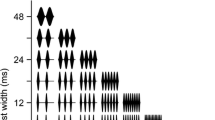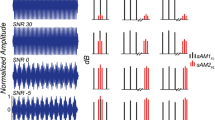Abstract
Neural coding of the slow amplitude fluctuations of sound (i.e., temporal envelope) is thought to be essential for speech understanding; however, such coding by the human auditory nerve is poorly understood. Here, neural coding of the temporal envelope by the human auditory nerve is inferred from measurements of the compound action potential in response to an amplitude modulated carrier (CAPENV) for modulation frequencies ranging from 20 to 1000 Hz. The envelope following response (EFR) was measured simultaneously with CAPENV from active electrodes placed on the high forehead and tympanic membrane, respectively. Results support the hypothesis that phase locking to higher modulation frequencies (> 80 Hz) will be stronger for CAPENV, compared to EFR, consistent with the upper-frequency limits of phase locking for auditory nerve fibers compared to auditory brainstem/cortex neurons. Future work is needed to determine the extent to which (1) CAPENV is a useful tool for studying how temporal processing of the auditory nerve is affected by aging, hearing loss, and noise-induced cochlear synaptopathy and (2) CAPENV reveals the relationship between auditory nerve temporal processing and perception of the temporal envelope.





Similar content being viewed by others
References
Bharadwaj HM, Masud S, Mehraei G, Verhulst S, Shinn-Cunningham BG (2015) Individual differences reveal correlates of hidden hearing deficits. J Neurosci 35:2161–2172
Bohorquez J, Ozdamar O (2008) Generation of the 40-Hz auditory steady-state response (ASSR) explained using convolution. Clinical Neurophysiology : Official Journal of the International Federation of Clinical Neurophysiology 119:2598–2607
Bourien J, Tang Y, Batrel C, Huet A, Lenoir M, Ladrech S, Desmadryl G, Nouvian R, Puel JL, Wang J (2014) Contribution of auditory nerve fibers to compound action potential of the auditory nerve. J Neurophysiol 112:1025–1039
Bramhall NF, McMillan GP, Kampel SD (2021) Envelope following response measurements in young veterans are consistent with noise-induced cochlear synaptopathy. Hear Res 408:108310
Chertoff ME (2004) Analytic treatment of the compound action potential: estimating the summed post-stimulus time histogram and unit response. J Acoust Soc Am 116:3022–3030
Chimento TC, Schreiner CE (1990) Selectively eliminating cochlear microphonic contamination from the frequency-following response. Electroencephalogr Clin Neurophysiol 75:88–96
Dallos P, Cheatham MA (1976) Production of cochlear potentials by inner and outer hair cells. J Acoust Soc Am 60:510–512
Don M, Allen AR, Starr A (1977) Effect of click rate on the latency of auditory brain stem responses in humans. Ann Otol Rhinol Laryngol 86:186–195
Eggermont JJ (2017) Ups and downs in 75 years of electrocochleography. Front Syst Neurosci 11:2
Glasberg BR, Moore BC (1989) Psychoacoustic abilities of subjects with unilateral and bilateral cochlear hearing impairments and their relationship to the ability to understand speech. Scand Audiol Suppl 32:1–25
Hancock KE, O’Brien B, Santarelli R, Liberman MC, Maison SF (2021) The summating potential in human electrocochleography: Gaussian models and Fourier analysis. J Acoust Soc Am 150:2492
Harris KC, Vaden KI Jr, McClaskey CM, Dias JW, Dubno JR (2018) Complementary metrics of human auditory nerve function derived from compound action potentials. J Neurophysiol 119:1019–1028
Henry KR (1995) Auditory nerve neurophonic recorded from the round window of the Mongolian gerbil. Hear Res 90:176–184
Huet A, Batrel C, Dubernard X, Kleiber JC, Desmadryl G, Venail F, Liberman MC, Nouvian R, Puel JL, Bourien J (2022) Peri-stimulus time responses predict adaptation and spontaneous firing of auditory-nerve fibers: from rodents data to humans. J Neurosci.
Jennings SG, Dominguez J (2022) Firing rate adaptation of the human auditory nerve optimizes neural signal-to-noise ratios. J Assoc Res Otolaryngol.
Jennings SG, Chen J, Fultz SE, Ahlstrom JB, Dubno JR (2018) Amplitude modulation detection with a short-duration carrier: effects of a precursor and hearing loss. J Acoust Soc Am 143:2232
Jorgensen S, Dau T (2011) Predicting speech intelligibility based on the signal-to-noise envelope power ratio after modulation-frequency selective processing. J Acoust Soc Am 130:1475–1487
Joris PX, Yin TC (1992) Responses to amplitude-modulated tones in the auditory nerve of the cat. J Acoust Soc Am 91:215–232
Joris PX, Schreiner CE, Rees A (2004) Neural processing of amplitude-modulated sounds. Physiol Rev 84:541–577
Junius D, Dau T (2005) Influence of cochlear traveling wave and neural adaptation on auditory brainstem responses. Hear Res 205:53–67
Kale S, Heinz MG (2010) Envelope coding in auditory nerve fibers following noise-induced hearing loss. J Assoc Res Otolaryngol 11:657–673
Kuwada S, Anderson JS, Batra R, Fitzpatrick DC, Teissier N, D’Angelo WR (2002) Sources of the scalp-recorded amplitude-modulation following response. J Am Acad Audiol 13:188–204
Liang L, Lu T, Wang X (2002) Neural representations of sinusoidal amplitude and frequency modulations in the primary auditory cortex of awake primates. J Neurophysiol 87:2237–2261
Linden RD, Campbell KB, Hamel G, Picton TW (1985) Human auditory steady state evoked potentials during sleep. Ear Hear 6:167–174
Lins OG, Picton PE, Picton TW, Champagne SC, Durieux-Smith A (1995) Auditory steady-state responses to tones amplitude-modulated at 80–110 Hz. J Acoust Soc Am 97:3051–3063
Margolis RH (1999) Electrocochleography. In: Seminars in hearing, pp 45–60: Copyright© 1999 by Thieme Medical Publishers, Inc.
Margolis RH, Rieks D, Fournier EM, Levine SE (1995) Tympanic electrocochleography for diagnosis of Meniere’s disease. Archives of Otolaryngology-Head and Neck Surgery 121:44–55
Margolis RH, Levine SC, Fournier EM, Hunter LL, Smith SL, Lilly DJ (1992) Tympanic electrocochleography: normal and abnormal patterns of response. Audiology 31:8–24
Mepani AM, Kirk SA, Hancock KE, Bennett K, de Gruttola V, Liberman MC, Maison SF (2020) Middle ear muscle reflex and word recognition in “normal-hearing” adults: evidence for cochlear synaptopathy? Ear Hear 41:25–38
Nelson PC, Carney LH (2007) Neural rate and timing cues for detection and discrimination of amplitude-modulated tones in the awake rabbit inferior colliculus. J Neurophysiol 97:522–539
Ohashi T, Ochi K, Nishino H, Kenmochi M, Yoshida K (2005) Recovery of human compound action potential using a paired-click stimulation paradigm. Hear Res 203:192–200
Peake WT, Kiang NY (1962) Cochlear responses to condensation and rarefaction clicks. Biophys J 2:23–34
Picton TW (2010) Human auditory evoked potentials: Plural Publishing.
Purcell DW, John SM, Schneider BA, Picton TW (2004) Human temporal auditory acuity as assessed by envelope following responses. J Acoust Soc Am 116:3581–3593
Santarelli R, Arslan E (2002) Electrocochleography in auditory neuropathy. Hear Res 170:32–47
Schaette R, McAlpine D (2011) Tinnitus with a normal audiogram: physiological evidence for hidden hearing loss and computational model. J Neurosci 31:13452–13457
Schreiner CE, Urbas JV (1986) Representation of amplitude modulation in the auditory cortex of the cat. I. The anterior auditory field (AAF). Hear Res 21:227–241
Shaheen LA, Valero MD, Liberman MC (2015) Towards a diagnosis of cochlear neuropathy with envelope following responses. J Assoc Res Otolaryngol 16:727–745
Shannon RV, Zeng FG, Kamath V, Wygonski J, Ekelid M (1995) Speech recognition with primarily temporal cues. Science 270:303–304
Simpson MJ, Jennings SG, Margolis RH (2020) Techniques for obtaining high-quality recordings in electrocochleography. Front Sys Neurosci 14:18
Stapells DR, Linden D, Suffield JB, Hamel G, Picton TW (1984) Human auditory steady state potentials. Ear Hear 5:105–113
Swaminathan J, Heinz MG (2012) Psychophysiological analyses demonstrate the importance of neural envelope coding for speech perception in noise. J Neurosci 32:1747–1756
Wallaert N, Moore BC, Ewert SD, Lorenzi C (2017) Sensorineural hearing loss enhances auditory sensitivity and temporal integration for amplitude modulation. J Acoust Soc Am 141:971–980
Winslow RL, Sachs MB (1988) Single-tone intensity discrimination based on auditory-nerve rate responses in backgrounds of quiet, noise, and with stimulation of the crossed olivocochlear bundle. Hear Res 35:165–189
Zhu L, Bharadwaj H, Xia J, Shinn-Cunningham B (2013) A comparison of spectral magnitude and phase-locking value analyses of the frequency-following response to complex tones. J Acoust Soc Am 134:384–395
Acknowledgements
This work was supported by Grant K23 DC-014752 from NIH/NIDCD. The authors thank Michael Simpson and Whitney England Hauver for assistance with data collection.
Author information
Authors and Affiliations
Corresponding author
Additional information
Publisher's Note
Springer Nature remains neutral with regard to jurisdictional claims in published maps and institutional affiliations.
Rights and permissions
About this article
Cite this article
Chen, J., Jennings, S.G. Temporal Envelope Coding of the Human Auditory Nerve Inferred from Electrocochleography: Comparison with Envelope Following Responses. JARO 23, 803–814 (2022). https://doi.org/10.1007/s10162-022-00865-z
Received:
Accepted:
Published:
Issue Date:
DOI: https://doi.org/10.1007/s10162-022-00865-z




